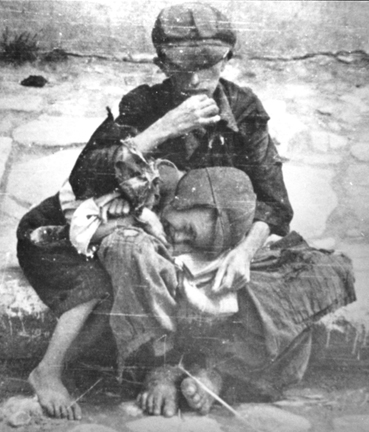The Warsaw Ghetto
 Jewish children in
the Warsaw Ghetto in 1942
Jewish children in
the Warsaw Ghetto in 1942
Before World War II started on September
1, 1939, there were 375,000 Jews living in Warsaw, as many as
in all of France, and more than in the whole country of Czechoslovakia.
Only the city of New York had a larger Jewish population than
Warsaw.
The first Jews had settled in Warsaw
after King Kasimierz the Great welcomed Jewish refugees from
Western Europe to Poland in the 14th century, but during the
15th century they were expelled from the city of Warsaw, just
as they were in Krakow. Between 1527 and 1768, Jews were banned
from living in Warsaw.
After Poland was partitioned for the
third time in 1795 between Russia, Prussia and Austria, the Jews
began coming back to Warsaw, which was in the Russian section,
and by the start of World War I, Jews made up forty percent of
the population of the city. During the 19th century and up until
the end of World War I, Warsaw was in the Pale of Settlement
where all Russian Jews were forced to live; when Poland regained
its independence after World War I, Warsaw was once again a Polish
city. From the beginning, the Jewish district was located southeast
of Old Town Warsaw.
The Nazis liked to take action against
the Jews on Jewish holidays, so it was on Yom Kippur, the Jewish
Day of Atonement, that the announcement was made on October 12,
1940 that "Jewish residential quarters" were to be
set up in Warsaw. The Ghetto would comprise 2.4 percent of the
city's land, but would contain 30% of the city's population,
according to the U.S. Holocaust Museum. To create the Ghetto,
the Nazis moved 113,000 Christian residents out and moved 138,000
Jewish residents in. The rest of the Warsaw Jews were already
living in the neighborhood of the Ghetto.
In the Warsaw Ghetto, 450,000 Jews were
forced to live in very crowded conditions. The population of
the Ghetto included Jews from the surrounding villages in the
General Government of German occupied Poland. The Ghetto was
divided into two sections, the Small Ghetto at the southern end
and the Large Ghetto on the north. By the time deportations to
the extermination camps began, about 100,000 residents of the
Ghetto had died of starvation or disease, according to Raul Hilberg.
This page was last updated on April 18,
2008
|